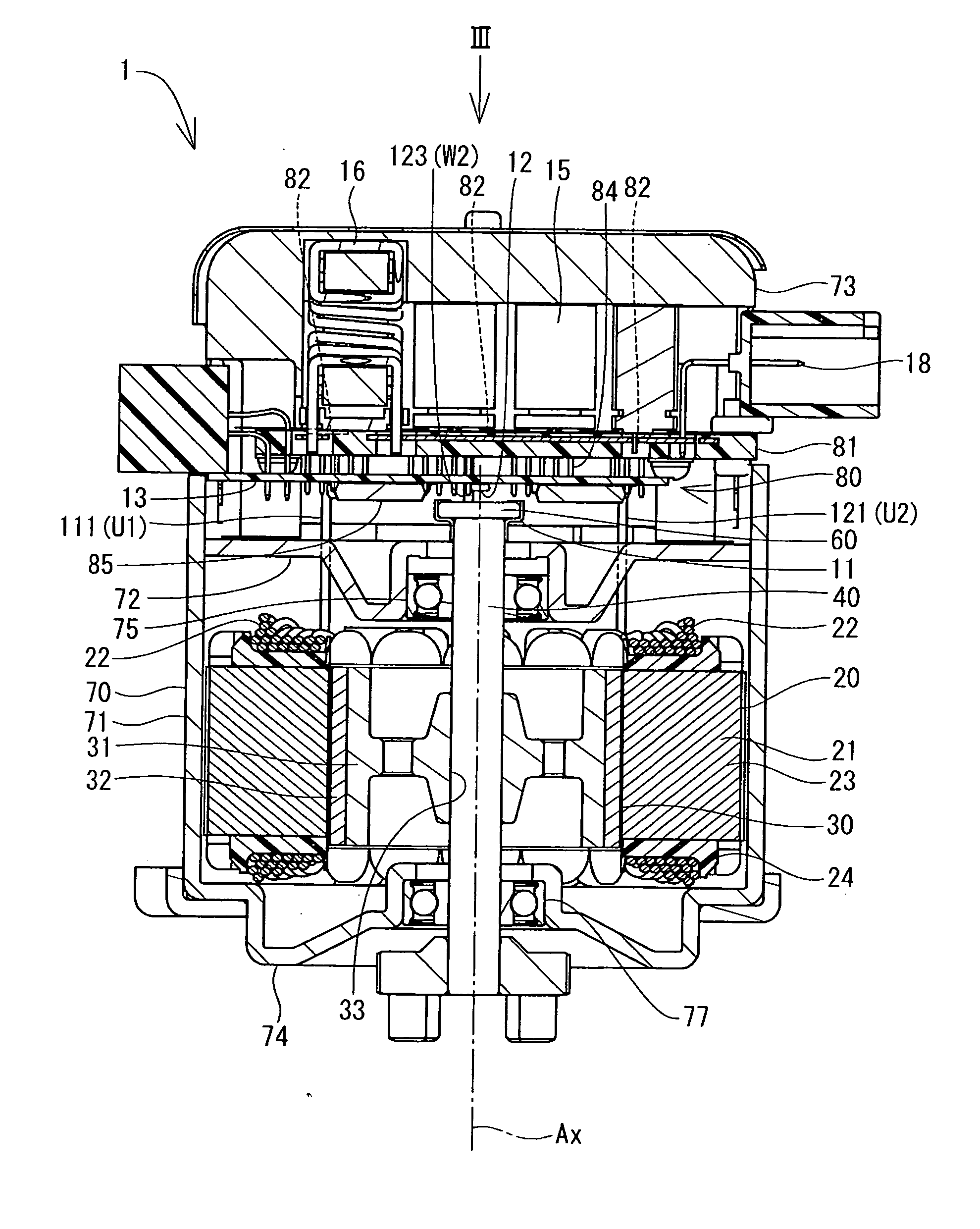Motor and electric power steering apparatus using motor
- Summary
- Abstract
- Description
- Claims
- Application Information
AI Technical Summary
Benefits of technology
Problems solved by technology
Method used
Image
Examples
first embodiment
[0018]With reference to FIGS. 1 and 2, a motor 1 is used in an electric power steering apparatus in a vehicle, which is not illustrated, and where the motor 1 provides power assistance steering to a driver of the vehicle.
[0019]The motor 1, with a central axis Ax, includes a stator 20, a rotor 30, a shaft 40, a magnet 60, a magnetic sensor 12, and a control unit 80. The stator 20 includes a plurality of salient poles 21. In the present embodiment, six salient poles 21 are arranged circularly at equal intervals to make the stator 20. The salient pole 21 includes laminated core 23 of layered thin magnetic material and an insulator 24 engaged with the laminated core 23 from a radial direction. Each of the insulators 24 includes a winding wire 22 wound thereon. When the electric power is supplied to the winding wire 22, the salient pole 21 produces magnetic force.
[0020]The rotor 30 is formed with magnetism materials, such as an iron in the shape of a pipe. The rotor 30 includes a rotor c...
second embodiment
[0049]The arrangement of the conducting wires-of the motor in the second embodiment of the present disclosure is illustrated in FIG. 4. Though the schematic configuration of the second embodiment is the same as the first embodiment, difference of the arrangement of the conducting wires connecting the winding wire 22 to the control unit 80 relative to the first embodiment is a focus of the explanation in the following description.
[0050]In the present embodiment, similarly to the first embodiment, each of the U phase conducting wire 111, the V phase conducting wire 112 and the W phase conducting wire 113 in the first system corresponds to “the first conducting wire” in claims. Each of the U phase conducting wire 121, the V phase conducting wire 122 and the W phase conducting wire 123 in the second system corresponds to “the second conducting wire” in claims. Further, each of a pair of the U phase conducting wire 111 and the U phase conducting wire 121, a pair of the V phase conducting...
third embodiment
[0063]The arrangement of the conducting wires of the motor in the third embodiment of the present disclosure is illustrated in FIG. 5. Though the schematic configuration of the third embodiment is the same as the first embodiment, difference of the arrangement of the conducting wires connecting the winding wire 22 to the control unit 80 relative to the first embodiment is a focus of the explanation in the following description.
[0064]In the present embodiment, each of the U phase conducting wire 111 the U phase conducting wire 121 corresponds to “the first conducting wire” in claims, and each of the V phase conducting wire 112 and the V phase conducting wire 122 corresponds to “the second conducting wire” in claims, and each of the W phase conducting wire 113 and the W phase conducting wire 123 corresponds to “the third conducting wire” in claims, which is different from the first embodiment. Further, each of a group of the U phase, conducting wire 111, the V phase conducting wire 11...
PUM
 Login to View More
Login to View More Abstract
Description
Claims
Application Information
 Login to View More
Login to View More - R&D
- Intellectual Property
- Life Sciences
- Materials
- Tech Scout
- Unparalleled Data Quality
- Higher Quality Content
- 60% Fewer Hallucinations
Browse by: Latest US Patents, China's latest patents, Technical Efficacy Thesaurus, Application Domain, Technology Topic, Popular Technical Reports.
© 2025 PatSnap. All rights reserved.Legal|Privacy policy|Modern Slavery Act Transparency Statement|Sitemap|About US| Contact US: help@patsnap.com



